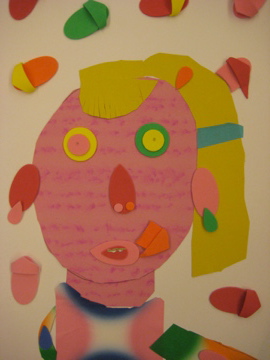
I tend to be very impressed with how the Museum of Modern Art presents artwork to elementary aged students. The museum educator picks images based on a theme, they lead the students through guided inquiry-based discussion of those images, students create sketches of ideas that are being presented to them, and they conclude the day by creating a work of art in the educational studios. MoMA has always been willing to make the tours as individualized as possible, so I always ask them to conclude the tour in the galleries displaying contemporary artwork.
Ms. Berry’s fourth grade class was recently led into the current exhibit, Here is Every: Four Decades of Contemporary Art, and the tour concluded with examining Arturo Herrera’s A Knock (2000). There is always something a little more exciting happening when students view contemporary art. It tends to lend itself to the natural sensibilities of children—a sense of fun, the whimsical nature of play, and a reflection of the world around us. When students encounter this work there seems to be a little more engagement on their part, possibly because the work genuinely reflects some of what they are thinking about. When the class sat in front of Herrera’s work and excitedly uncovered the many layers that exist in the piece, they began identifying the shapes and forms hidden within his cutouts and slowly realizing he used comics as his source material.
Personally, I have loved Herrera’s work for quite some time. But I was pleasantly surprised when our tour finished with A Knock because I knew that I could share Herrera’s Art:21 segment as a follow-up. My fourth graders loved seeing Herrera work in his studio and explore the different materials that he uses, especially the photo based work. Seeing the studio practice of artists can demystify the artistic process. Not only does it give a student the chance to say that “I can do that” but it gives them the chance to say “I DO THAT!”
What is so impressive about Herrera’s creative process is that it truly embodies how fourth graders create. Watching Herrera play with the images for his collage is the exact approach my students take….they re-contextualize the visual imagery in front of them to create some type of meaning. When students are presented with the question, “What does it mean for a work of art to be a portrait?,” they are now meaningfully engaged in the same type of questions that contemporary artists battle. Children have a wonderful ability to represent their reality in a way that offers terrific surprises in the same way Herrera uncovers in his work.
Collage created by Emily, age 9, Hillside School, New York.




